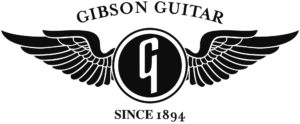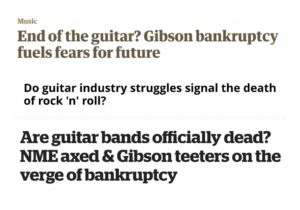That Gibson Elephant Jamming in the Room

Gibson has suffered through a long, hard season of getting its butt handed to it. Financial meltdown. Horrible company culture. The “Wood Incident.” Quality control out of control, and careening downward. Innovations players were so not jazzed about. A CEO (Henry Juszkiewicz) who was once a savior of the beloved brand, but somehow, as the years passed, de-evolved into a pariah. In short, a mess. A joke. An “I told you so” story from the mouths of guitarists who love talking smack.
How does a company come back from all of this?
Well, I certainly can’t speak to the potentially ongoing side effects of Gibson’s bankruptcy, the expectations of investors, profit projections, or the return-on-investment proposition of everything it may take to turn the company around. That stuff is so above my pay grade that it might as well be buried in the golden sands of Mars.
But, thanks to my two-plus decades at Guitar Player, I feel that I can definitely discuss how guitarists may be viewing the passion play of the post-Juszkiewicz era of Gibson. And here we go…
Act I: The Comedy of 6-Strings Laughing

As talk of bankruptcy fluttered around the guitar community prior to Gibson’s official filing in May 2018, the mainstream press once again cranked up reports of the “death of the guitar.” Well, ya gotta go after that click bait, right? Sigh. But guitarists—those who live to cradle their beloved guitars every day in the quest for excellence or solace, and who also buy gear, form bands, play for fun, and are otherwise completely obsessed with the sound of a guitar—certainly knew better. The fortunes of one or two guitar companies, the cyclical mischief of popular music charts, and the health of the record industry were not going to kill off our objects of desire, or weaken our commitment to making music with them. And, in fact, those in the know knew that many guitar manufacturers were doing “just fine thank you” and talented guitarists—many of them women and 20-somethings—were blowing up YouTube and social networks with transcendent playing. So while it was somewhat amusing to read the so-called obituaries, I think we all understand that a prognosticator has to embark on a far deeper dive than a facile headline and a couple of interview snippets to fully understand and foretell where the guitar may be going. And, no, Gibson troubles never were the harbingers of doom for the guitar. Get real. Duh.
Act II: Don’t Care About Us, and We Won’t Care About You

If quality starts sucking for a legendary and upscale brand, at some point, even true believers will start to waver. Arguably, this happened for Gibson in the “Norlin era” (approximately 1969-1985), and, apparently, the company had forgotten that low point the past few years. At Guitar Player, the most humorous/sad example was when we received a Les Paul with the robot tuners. It didn’t work. So the company sent us a new one, and then another, and then another. None of them managed to accurately tune six strings. I think we had about five or six robot-equipped Les Pauls in our storage closet, and they stayed there. Of course, this was, for the most part, a technology issue, but during the same period we’d also get in expensive Gibson models with finish glitches and other boo-boos you’d shouldn’t see on a luxury guitar. In fact, Gibson’s Epiphone line pretty much destroyed the average core Gibson in quality workmanship and attention to detail. Even stranger, we’d occasionally receive a beautiful Gibson model for review, and then hear it had been discontinued or de-emphasized, or that the company would prefer we’d evaluate another model instead. What?
The good news from NAMM 2019 is that quality appears to be rockin’. We’ll have to wait and see how the models that make it into players’ hands throughout the year fare, but, whoa, everything I loved about the awesomeness of a Gibson guitar was in full flower for each and every model I checked out in the company’s booth.
Act III: Meet the New Boss. Definitely NOT the Old Boss

We told him. “Don’t take that job at Gibson. You’re crazy!” He did. And he was miserable. I was never an employee at Gibson—and, truth be told, I never had a bad interaction with Henry Juszkiewicz (he was always polite and engaging to me while I was at GP)—but, although I didn’t experience the “Gibson Experience” first-hand, stories from former Gibson staffers about the challenges of working there are legion. The morale of the rank-and-file can’t help but inform a company’s products—especially in the hand-built, emotion-driven guitar industry—so it’s not really a surprise that pride, quality, and give-a-shit-ness had diminished at Gibson.
I think that’s gonna change.
New Gibson CEO James Curleigh said all the right things in every interview he did at NAMM. He absolutely respected the brand’s legacy, and he didn’t spin or avoid speaking honestly about the company’s problems and challenges. I didn’t have a chance to speak to Curleigh personally, but some friends and industry peers who I respect did, and they said they were impressed by the man’s casual style, his obvious enthusiasm about guitar, and his initial strategy for bringing back esteem for the brand. In addition, people who actually work for Gibson appeared to be energized and hopeful for the future. A good sign!
Act IV: We Love Gibson

I never personally talked to any player who ever wanted Gibson to die—even those who were extremely fed up with the company’s expensive guitars that didn’t measure up to the prices they were asking for them. All-in-all, Gibson is a legendary and iconic brand that casts an immeasurably deep resonance across rock, blues, jazz, and country. So, although the company has tripped up and frustrated us and maybe even angered us, I think most of us are pulling for Gibson’s success and hoping for a Renaissance. So there you go. ‘Nuff said.
Act V: Triumphant Return to NAMM

If you wanted to lose a few pounds at NAMM 2019—perhaps you’d partaken of too many high-calorie business meetings at the Anaheim Morton’s or tipped over your alcoholic beverage limit—all you had to do was visit the Gibson booth. That joint was always over-packed with bodies and hotter than hell. It was like a sauna, and I found that I could comfortably handle maybe ten minutes in there without feeling like I needed a cool-down shower. This is a good thing. After being absent from Winter NAMM in 2018, Gibson came back roaring with a huge room, a stage with musicians performing throughout the day, stations where builders explained their craft, glass-protected order books from the ’50s (one stating, “Les Paul for Les Paul”), and tons of new products. See Act IV above—people want Gibson to succeed. Even their competitors. One said, “A strong Gibson is good for all of us.” Word.
Act VI: Walk It Like You Talk It

About the only thing that could tank all of the anticipation and goodwill for Gibson’s success in 2019 is Gibson. The stage has been set, and now comes the follow-through.
Obviously, the brand is still making relatively expensive guitars that will continue to be out of the reach of some players. (The least expensive debut I saw was for the $799 Les Paul Junior Tribute DC.) But for those who can afford the upscale production or Custom Shop models, the promises of better quality control had better be locked down and plain to see. (To be fair, most of the quality complaints were focused on production-line models. I only personally heard one or two grumbles about Gibson Custom Shop instruments, and a player I greatly respect—Johnny A—has been a stone believer in what the Custom Shop produces, and happily promotes the guitars they build for him on Facebook.)
It will also be interesting to see how Gibson manages innovation in the coming months.
Yepper—no one probably wants to see high-tech gizmos attached to Gibson guitars any more, but there are still the challenges of seducing new players and not repeating yourself into boredom with constant iterations of models developed in the 1950s. Fender’s Andy Mooney—another corporate “outsider” who previously worked for Nike and Disney, just as Curleigh comes from Levi’s—certainly helped move his brand into thrilling new arenas (such as the Parallel Universe and Alternate Reality lines and the new pedal line) while simultaneously retaining the Leo Fender DNA. Enticing young players—both male and female—to champion (and purchase) your guitars is a treacherous gig that would give me an ulcer in days, but I always enjoy decoding the strategies of manufacturers far smarter than I to see how such a thing can be accomplished. You’re up to the plate, Gibson!
In closing, I must be transparent and admit that, while I adore tons of guitars from myriad makers, it was the Gibson Les Paul in the hands of players such as Jimmy Page, Marc Bolan, Pete Townshend, and Mick Ronson (to name-check but a few) that inspired me to play guitar and commit my life to this blissful, challenging, and whacky ride as a guitarist, musician, and music journalist. I fly my Les Paul flag proudly and high, and I hope that Curleigh and his crew at Gibson continue to astound new players and old with the same magic that changed my life in the ’60s and ’70s. Welcome back to the battle, Gibson!




I’m with you! Gibson is just too much of a daily requirement and it’d be sad to not have them making good guitars again!
I wish them the best of luck with rebuilding this company, and it seems like they’ve got their good foot forward!
P.S. Some folks don’t care for them, but I love my ’79 Les Pau Standard! This Norlin is a keeper that I bought new with it’s funky chainsaw-looking case! Can’t get a top-shelf Epiphone for what they went for back then!
A great article, well done! And I, too, have a ’79 LPS just like Harry: it has been my pride and joy since 1987, in spite of a few little cosmetic booboos.
Another person (new to me at least) who I thought was awesome during the NAMM 2019 coverage was Gibson’s Chief Merchant Officer, Cesar Gueikian.
This might be one of the best things you’ve ever written, Michael. Both honest and hopeful, I think it expresses the feelings of guitar players all over the world when the Gibson brand is discussed among friends & players.
To Gibson I can only say, “Make them better and make them less expensive… but mostly, make them better.”